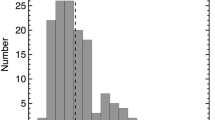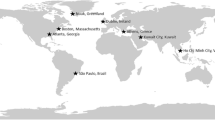Abstract
Retrospective descriptive secondary analyses of data from relationships of indoor, outdoor, and personal air (RIOPA) study homes (in Houston, Texas; Los Angeles County, California; and, Elizabeth, New Jersey May 1999–February 2001) were conducted. Data included air exchange rates, associations between indoor and outdoor temperature and humidity, and calculated apparent temperature and humidex. Analyses examined if study homes provided optimum thermal comfort for residents during both heating and cooling seasons when compared to current American Society of Heating, Refrigerating and Air Conditioning Engineers (ASHRAE) Standards 62/62.1 and 55. Results suggested outdoor temperature, humidex, and apparent temperature during the cooling season potentially served as indicators of indoor personal exposure to parameters of thermal comfort. Outdoor temperatures, humidex, and apparent temperature during the cooling season had statistically significant predictive abilities in predicting indoor temperature. During the heating season, only humidex in Texas and combined data across study states were statistically significant, but with weaker to moderate predicative ability. The high degree of correlation between outdoor and indoor environmental variables provided support for the validity of epidemiologic studies of weather relying on temporal comparisons. Results indicated most RIOPA study residents experienced thermal comfort; however, many values indicated how several residents may have experienced some discomfort depending on clothing and indoor activities. With climate change, increases in temperature are expected, with more days of extreme heat and humidity and, potentially harsher, longer winters. Homes being built or modernized should be created with the appropriate guidelines to provide comfort for residents daily and in extreme weather events.


Similar content being viewed by others
References
ASHRAE (2013) ASHRAE Handbook Fundamentals (SI), Standard 55. Thermal Comfort, American Society of Heating, Refrigerating and Air Conditioning Engineering, Inc (ASHRAE)
Blazejczyk K, Epstein Y, Jendritzky G, Staiger H, Tinz B (2012) Comparison of UTCI to selected thermal indices. Int J Biometeorol 56(3):515–535. doi:10.1007/s00484-011-0453-2
D’Ambrosio Alfano FR, Palella BI, Riccio G (2011) Thermal environment assessment reliability using temperature—humidity indices. Ind Health 49(1):95–106
Davis LW, Gertler PJ (2015) Contribution of air conditioning adoption to future energy use under global warming. PNAS 112(19):5962–5967
de Freitas CR, Grigorieva EA (2015) A comprehensive catalogue and classification of human thermal climate indices. Int J Biometeorol 59(1):109–120. doi:10.1007/s00484-014-0819-3
Ebi KL, Kovats RS, Menne B (2006) An approach for assessing human health vulnerability and public health interventions to adapt to climate change. Environ Health Perspect 114(12):1930–1934
Giannaros TM, Melas D, Matzarakis A (2015) Evaluation of thermal bioclimate based on observational data and numerical simulations: an application to Greece. Int J Biometeorol 59(2):151–164. doi:10.1007/s00484-014-0832-6
Gosling SN, McGregor GR, Lowe JA (2009) Climate change and heat-related mortality in six cities part 2: climate model evaluation and projected impacts from changes in the mean and variability of temperature with climate change. Int J Biometeorol 53(1):31–51
Hajat S, O’Connor M, Kosatsky T (2010) Health effects of hot weather: from awareness of risk factors to effective health protection. Lancet 375(9717):856–863
Hondula DM, Georgescu M, Balling RC Jr (2014) Challenges associated with projecting urbanization-induced heat-related mortality. Sci Total Environ 490:538–544
Hoppe P, Martinac I (1998) Indoor climate and air quality. Review of current and future topics in the field of ISB study group 10. Int J Biometeorol 42:1–7
Huang C, Barnett AG, Xu Z, Chu C, Wang X, Turner LR, Tong S (2013) Managing the health effects of temperature in response to climate change: challenges ahead. Environ Health Perspect 121(4):415–419
Jendritzky G, de Dear R, Havenith G (2012) UTCI—why another thermal index? Int J Biometeorol 56(3):421–428. doi:10.1007/s00484-011-0513-7
Kampmann B, Bröde P, Fiala D (2012) Physiological responses to temperature and humidity compared to the assessment by UTCI, WGBT and PHS. Int J Biometeorol 56(3):505–513. doi:10.1007/s00484-011-0410-0
Krüger EL, Minella FO, Matzarakis A (2014) Comparison of different methods of estimating the mean radiant temperature in outdoor thermal comfort studies. Int J Biometeorol 58(8):1727–1737. doi:10.1007/s00484-013-0777-1
Maibach EW, Chadwick A, McBride D, Chuk M, Ebi KL, Balbus J (2008) Climate change and local public health in the United States: preparedness, programs and perceptions of local public health department directors. PLoS One 3(7):e2838
Masterson JM, Richardson FA (1979) Humidex, a method of quantifying human discomfort due to excessive heat and humidity. Environment Canada, Atmospheric Environment Service, Downsview; Ontario
Matzarakis A, Endler C (2010) Climate change and thermal bioclimate in cities: impacts and options for adaptation in Freiburg, Germany. Int J Biometeorol 54(4):479–483. doi:10.1007/s00484-009-0296-2
Mazon J (2014) The influence of thermal discomfort on the attention index of teenagers: an experimental evaluation. Int J Biometeorol 58(5):717–724. doi:10.1007/s00484-013-0652-0
McMichael AJ, Woodruff RE, Hales S (2006) Climate change and human health: present and future risks. Lancet 367(9513):859–869
Meehl GA, Tebaldi C (2004) More intense, more frequent, and longer lasting heat waves in the twenty-first century. Science 305:994–997
Michelozzi P, Accetta G, De Sario M, et al. (2009) High temperature and hospitalizations for cardiovascular and respiratory causes in 12 European cities. Am J Respir Crit Care Med 179:383–389
Nguyen JL, Schwartz J, Dockery DW (2014) The relationship between indoor and outdoor temperature, apparent temperature, relative humidity, and absolute humidity. Indoor Air 24(1):103–112. doi:10.1111/ina.12052
Orosa JA, Costa AM, Rodríguez-Fernández A, Roshan G (2014) Effect of climate change on outdoor thermal comfort in humid climates. Environ Health Sci Eng 12(1):46
Papanastasiou DK, Melas D, Bartzanas T, Kittas C (2010) Temperature, comfort and pollution levels during heat waves and the role of sea breeze. Int J Biometeorol 54(3):307–317. doi:10.1007/s00484-009-0281-9
Pappenberger F, Jendritzky G, Staiger H, Dutra E, Di Giuseppe F, Richardson DS, Cloke HL (2015) Global forecasting of thermal health hazards: the skill of probabilistic predictions of the universal thermal climate index (UTCI). Int J Biometeorol 59(3):311–323. doi:10.1007/s00484-014-0843-3
Provençal S, Bergeron O, Leduc R, Barrette N (2015) Thermal comfort in Quebec City, Canada: sensitivity analysis of the UTCI and other popular thermal comfort indices in a mid-latitude continental city. Int J Biometeorol. In press
Quinn A, Tamerius JD, Perzanowski M, Jacobson JS, Goldstein I, Acosta L, Shaman J (2014) Predicting indoor heat exposure risk during extreme heat events. Sci Total Environ 490:686–693. doi:10.1016/j.scitotenv.2014.05.039
Rana R, Kusy B, Jurdak R, Wall J, Hu W (2013) Feasibility analysis of using humidex as an indoor thermal comfort predictor. Energ Buil 64:17–25
Rhomberg LR, Chandalia JK, Long CM, Goodman JE (2011) Measurement error in environmental epidemiology and the shape of exposure-response curves. Crit Rev Toxicol 41(8):651–671
Rodríguez Algeciras JA, Matzarakis A (2015) Quantification of thermal bioclimate for the management of urban design in Mediterranean climate of Barcelona, Spain. Int J Biometeorol. In press
Rodríguez Algeciras JA, Coch H, De la Paz Pérez G, Chaos Yeras M, Matzarakis A (2015) Human thermal comfort conditions and urban planning in hot-humid climates-The case of Cuba. Int J Biometeorol. In press
Saha MV, Davis RE, Hondula DM (2014) Mortality displacement as a function of heat event strength in 7 US cities. Am J Epidemiol 179(4):467–474
Sheridan SC, Allen MJ, Lee CC, Kalkstein LS (2012) Future heat vulnerability in California, part II: projecting future heat-related mortality. Clim Chang 115(2):311–326
Smargiassi A, Fournier M, Griot C, Baudouin Y, Kosatsky T (2008) Prediction of the indoor temperatures of an urban area with an in-time regression mapping approach. J Expo Sci Environ Epidemiol 18(3):282–288
Smoyer-Tomic KE, Rainham DG (2001) Beating the heat: development and evaluation of a Canadian hot weather health-response plan. Environ Health Perspect 109(12):1241–1248
Steadman RG (1984) A universal scale of apparent temperature. J Climate Appl Meteorol 23(12):1674–1687. http://dx.doi.org/10.1175/1520-0450(1984)023<1674:AUSOAT>2.0.CO;2
Taesler R (1991) The bioclimate in temperate and northern cities. Int J Biometeorol 35(3):161–168
U.S. Environmental Protection Agency. (2014) Climate change indicators in the United States, 2014. Third edition. EPA 430-R-14-004. www.epa.gov/climatechange/indicators
Uejio C, Tamerius J, Vredenburg J, Asaeda G, Isaacs DA, Braun J, Quinn A, Freese JP (2015) Summer indoor heat exposure and respiratory and cardiovascular distress calls in New York City, NY U.S. Indoor Air, in press (as of June 18, 2015). doi: 10.1111/ina.12227
Van Hoof J, Mazej M, Hensen JL (2010) Thermal comfort: research and practice. Front Biosci (Landmark Ed) 15:765–788
Weisel CP, Zhang J, Turpin BJ, Morandi MT, Colome S, Stock TH, Spektor DM, Korn L, Winer A, Alimokhtari S, Kwon J, Mohan K, Harrington R, Giovanetti R, Cui W, Afshar M, Maberti S, Shendell D (2005) Relationship of indoor, outdoor and personal air (RIOPA) study: study design, methods and quality assurance/control results. J Expo Anal Environ Epidemiol 15(2):123–137
White-Newsome JL, Sánchez BN, Jolliet O, Zhang Z, Parker EA, Dvonch JT, O’Neill MS (2012) Climate change and health: indoor heat exposure in vulnerable populations. Environ Res 112:20–27. doi:10.1016/j.envres.2011.10.008
World Meteorological Organization. (2015). WMO, WHO issue guidance on heat health warning systems. PreventionWeb. http://preventionweb.net/go/45026
Yahia MW, Johansson E (2013) Evaluating the behaviour of different thermal indices by investigating various outdoor urban environments in the hot dry city of Damascus, Syria. Int J Biometeorol 57(4):615–630. doi:10.1007/s00484-012-0589-8
Yamamoto N, Shendell DG, Winer AM, Zhang J (2010) Residential air exchange rates in three major U.S. metropolitan areas: results from the relationship among indoor, outdoor and personal air study 1999-2001. Indoor Air 20(1):85–90
Zeger SL, Thomas D, Dominici F, Samet JM, Schwartz J, Dockery D, Cohen A (2000) Exposure measurement error in time-series studies of air pollution: concepts and consequences. Environ Health Perspect 108(5):419–426
Zeng Y, Dong L (2015) Thermal human biometeorological conditions and subjective thermal sensation in pedestrian streets in Chengdu, China. Int J Biometeorol 59(1):99–108. doi:10.1007/s00484-014-0883-8
Zhang K, Chen YH, Schwartz JD, Rood RB, O’Neill MS (2014) Using forecast and observed weather data to assess performance of forecast products in identifying heat waves and estimating heat wave effects on mortality. Environ Health Perspect 122(9):912–918
Acknowledgments
This project was completed during the MPH fieldwork of the first author; there were no external funding sources to report. We thank Dr. Qingyu Meng, PhD, MS (Rutgers School of Public Health (SPH)) and Angelo Bellomo, MS (Los Angeles County Department of Public Health) for input and Alexa Patti, BS, REHS, MPH (Rutgers SPH) for draft manuscript review.
Author information
Authors and Affiliations
Corresponding author
Appendix
Appendix
Rights and permissions
About this article
Cite this article
Garcia, F., Shendell, D.G. & Madrigano, J. Relationship among environmental quality variables, housing variables, and residential needs: a secondary analysis of the relationship among indoor, outdoor, and personal air (RIOPA) concentrations database. Int J Biometeorol 61, 513–525 (2017). https://doi.org/10.1007/s00484-016-1229-5
Received:
Revised:
Accepted:
Published:
Issue Date:
DOI: https://doi.org/10.1007/s00484-016-1229-5




